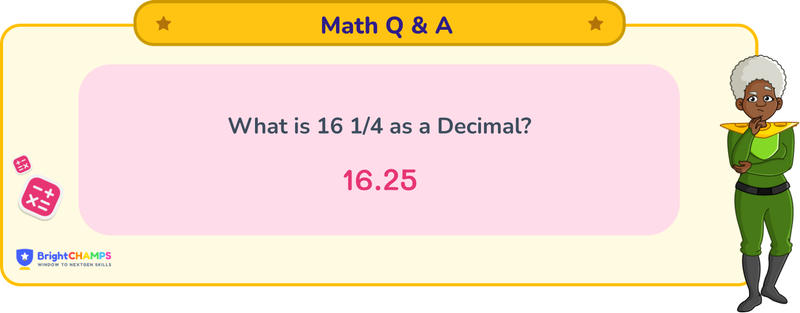
 4125 Learners
4125 LearnersLast updated on May 26th, 2025

16 1/4 as a Decimal

It is a simple question on decimal conversion. Firstly, we have to learn fractions and decimals. A fraction represents a part from the whole. It has two parts: the numerator (the number on top) here, 1 represents how many parts out of the whole. The denominator (the number below) shows how many parts make the whole; here, it is 4. A decimal is a way to represent a number that is not whole, using a decimal point (.) to separate the whole part from the fraction part. The numbers to the left of the decimal point represent the whole, and those to the right represent the fractional part.
What is 16 1/4 as a decimal?

Answer
16 1/4 as a decimal can be written as 16.25. It is a terminating decimal, as the division ends after a finite number of steps.
Explanation
To convert 16 1/4 to a decimal, we first convert the fractional part into a decimal and then add it to the whole number. Let's see the step-by-step breakdown of the process:
Step 1: Identify the whole number and the fraction. Here, the whole number is 16, and the fraction is 1/4.
Step 2: Convert the fraction 1/4 into a decimal by dividing 1 by 4.
Step 3: 1 divided by 4 gives 0.25, which is a terminating decimal.
Step 4: Add the decimal 0.25 to the whole number 16.
Step 5: The result is 16.25. Thus, 16 1/4 as a decimal is 16.25.
Struggling with Math?
Get 1:1 Coaching to Boost Grades Fast !

Important Glossaries for 16 1/4 as a decimal
- Fraction: A numerical quantity that is not a whole number, representing a part of a whole.
- Decimal: A number that uses the base ten and includes a decimal point to separate the whole part from the fractional part.
- Mixed Number: A number consisting of an integer and a proper fraction.
- Terminating Decimal: A decimal that ends and does not repeat infinitely.
- Division: A mathematical operation where a number is divided into equal parts.




